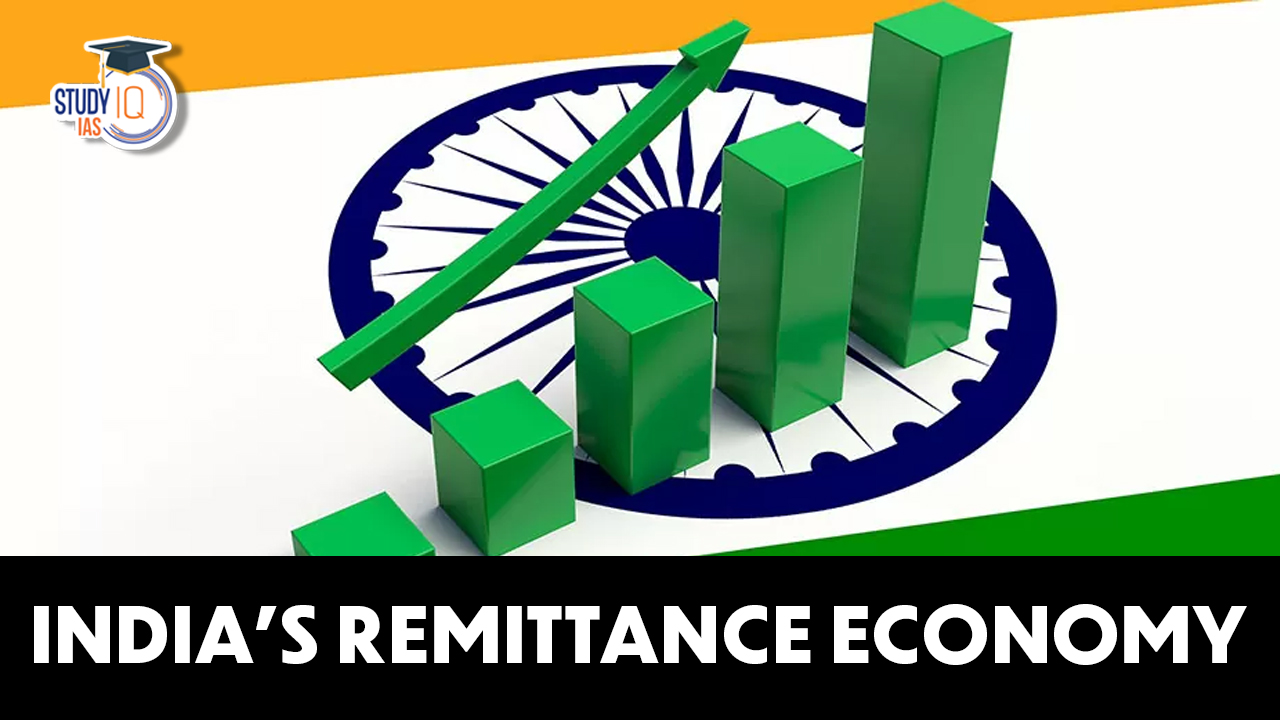Table of Contents
Context: According to the World Bank’s latest Migration and Development Brief, India is expected to post a growth of just 0.2% in remittance inflows in 2023.
More on the News
- The previous remittance record of India was $111 billion in 2022 that represents a growth rate of over 24% compared to the previous year.
- However, the projection for remittance inflows in 2023 is significantly lower. It is expected that India will only experience a growth rate of 0.2% in remittances for that year.
Key Observations of the Report
- Slowing Remittance Growth: Remittance growth in India and other South Asian countries is expected to be limited in 2023.
- Remittances to India, which constitute a significant portion of South Asian inflows, are projected to grow by only 0.2% in that year.
- The growth of remittances in the other six South Asian countries will also be constrained (lowest remittance growth rate in 2023 at 0.3%).
- Causes: The reasons for the decrease in remittances and the slower growth rate in 2023 include:
- Slower growth in OECD economies, particularly in the high-tech sector in the United States, can affect the demand for information technology (IT) workers. This can lead to a decrease in the demand for Indian IT professionals working abroad and subsequently impact the flow of remittances.
- This slowdown may lead to a diversion of formal remittances toward informal money transfer channels.
- The lower demand for migrants in the Gulf Cooperation Council (GCC) countries is another contributing factor. Declining oil prices have affected the economic growth of these countries, leading to a reduced need for migrant workers.
- The decline in oil prices is expected to slow down the economic growth of the GCC countries from 5.3% in 2022 to 3% in 2023, affecting remittance flows.
- Since the GCC countries are a key destination for Indian migrants, the decrease in demand has an impact on remittance flows.
- Additionally, factors such as weak balance-of-payments conditions, and exchange controls are anticipated to divert remittances to informal money transfer channels in countries like Pakistan, Bangladesh, and Sri Lanka.
- Highest Remittance Growth: Latin America and the Caribbean are expected to have the highest growth rate for remittances in 2023, with a forecast of 3.3%.
- This is attributed to the strong labour market conditions in the United States, which serves as a major destination for migrants from the region.
- Top Sources of Remittances for India: According to the report, the top sources of remittances for India are:
- United States: The US is one of the high-income destinations contributing significantly to India’s remittance inflows. Indian migrants, especially high-skilled and high-tech professionals, make up a substantial portion of the workforce in the US, and their remittances constitute a significant share of India’s total remittances.
- United Kingdom: The UK is another high-income destination from which India receives a substantial amount of remittances. Indian migrants residing and working in the UK, including skilled professionals, contribute to the remittance inflows.
- Singapore: Singapore is identified as one of the high-income destinations that contribute to India’s remittance inflows. Indian migrants, particularly those working in high-skilled and high-tech sectors, play a significant role in remitting funds back to India from Singapore.
- Gulf Cooperation Council (GCC) countries: The GCC countries, which include nations like Saudi Arabia, United Arab Emirates, Qatar, and others, remain the single largest destination for less-skilled South Asian migrants, including Indians. Remittances from GCC countries account for about 28% of India’s total remittance inflows. High energy prices and favourable economic conditions in these countries have facilitated increased employment opportunities and incomes for less-skilled Indian migrants, leading to higher remittance flows.
- Remittance Growth 2022 vs 2023 in other regions:
| Region | Remittance Inflows 2022 | Projected Remittance Growth Rate 2023 | Reasons for Change |
| South Asia | $176 billion | 0.3% | Slowing demand for skilled IT workers, tighter monetary policies, weaker GDP growth, lower fuel prices affecting GCC countries. |
| East Asia and Pacific (excluding China) | $130 billion | 1% | Central banks’ tight monetary stances, high debt levels, global uncertainty, lower demand for manufactured goods. |
| Europe and Central Asia | $79 billion | 1% | High base effect, weakness in flows to Ukraine and Russia, weaker Russian ruble against the US dollar. |
| Middle East and North Africa | $64 billion | 1.7% | Decline in oil prices, rebound in remittances to Egypt. |
| Sub-Saharan Africa | $53 billion | 1.3% | Various economic factors affecting remittance flows. |
- Importance of Remittances: The report observes the following importance of remittances:
- Complementing Other Financial Flows: Remittances serve as a substantial complement to other financial flows such as foreign direct investment (FDI) and official development assistance (ODA). In 2022, remittances measured 326% of FDI inflows and 1,036% of ODA, highlighting their importance alongside these financial inflows.
- Economic Lifeline During the Pandemic: Remittances have emerged as a financial lifeline for many economies during the Covid-19 pandemic. They have provided essential support to households and helped mitigate the economic impacts of the crisis, making them even more critical in the foreseeable future.
- Contribution to GDP: While the proportion of remittances to GDP varies across countries, they play a significant role in the economies of many nations. In South Asia, for example, remittances accounted for a substantial share of GDP in countries like Nepal (23.1%), Pakistan (7.9%), Sri Lanka (5.1%), and Bangladesh (4.7%).
- Funding Current Account and Fiscal Shortfalls: Remittance inflows are crucial for funding current account deficits and fiscal shortfalls in certain countries. For example, in countries like Tajikistan (51% of GDP), Tonga (44%), Lebanon (35%), Samoa (34%), and the Kyrgyz Republic (31%), remittances represent a large share of GDP, indicating their significance in addressing financial gaps.
Other Significance of remittances
- Poverty Reduction: Remittances have a direct impact on poverty reduction. They provide a lifeline to families in economically disadvantaged regions, enabling them to meet basic needs such as food, shelter, and healthcare. Remittances can help alleviate financial hardships and improve the living standards of the recipients.
- Resilience and Stability: Remittances often prove to be resilient during times of economic uncertainty, such as the Covid-19 pandemic. While there were concerns that remittances might decline due to travel restrictions and economic downturns, they have shown resilience and continued to flow. This resilience helps sustain consumer spending, support local economies, and mitigate the negative impacts of economic hardships.
- Social Impact: Beyond the economic aspect, remittances have social significance. They strengthen family ties and provide emotional support by allowing migrants to support their loved ones from afar. Remittances contribute to social stability, help maintain social networks, and foster a sense of belonging within migrant communities.
Understanding Remittances
What are Remittances?
- Remittances are funds that are sent by individuals, typically immigrants, to another party, often their family or relatives in another country.
- These funds are usually sent to support the financial needs of the recipient, such as covering daily expenses, healthcare, education, or investments.
Types of Remittances:
- Inward Remittances: These are funds transferred from abroad to India. They are typically of a personal nature and are sent to support family members. Inward remittances are sent by individuals living outside of India to their beneficiaries in India.
- Outward Remittances: These are funds transferred from India to countries outside of India. Outward remittances are typically made for various purposes such as education expenses, medical treatment, travel, or investment abroad. Indian individuals can transfer a certain amount per fiscal year under the Liberalised Remittance Scheme (LRS).
Modes of Remittances
The modes of remittances include:
- Check: Remittances can be sent through physical checks, which can be deposited into a bank account in India.
- Demand Drafts: Demand drafts are issued by banks and can be used to transfer funds. They provide a secure and convenient way of remitting money.
- Money Transfer Agents: Money transfer agents are intermediaries that facilitate the transfer of funds between individuals or entities. These agents can be physical locations or online platforms.
- Banks: Banks offer various services for remittances, including wire transfers, electronic transfers, and online banking platforms. They are a common and reliable method for sending and receiving remittances.
- Wise Transfers: Wise (formerly known as TransferWise) is an online money transfer service that allows individuals to send money internationally at competitive exchange rates.
- Online Money Transfer Specialists: There are online platforms and specialized money transfer services that focus on international remittances. These platforms offer convenience, speed, and competitive rates for sending money across borders.
- Digital Wallets: Digital wallets, such as PayPal and Paytm, can also be used for remittances. These wallets allow users to store money digitally and transfer funds to other individuals or merchants.
Challenges
- High Cost: Remittances can be expensive, with fees and exchange rate margins imposed by financial institutions and money transfer operators. This can significantly reduce the amount of money received by the beneficiaries.
- Limited Transparency: The methodology used by countries to record remittance inflows is often not made public. This lack of transparency can make it challenging to track and monitor remittance flows, which can be exploited for illicit purposes such as money laundering or terrorism financing.
- Compliance and Regulatory Concerns: Remittances are subject to compliance and regulatory requirements aimed at preventing financial crimes. Financial intelligence units and regulatory bodies need to ensure that remittances are not used for illicit activities.
- Lack of Financial Inclusion: Despite efforts to promote financial inclusion, many individuals, especially in low-income and remote areas, still lack access to formal financial services. This can hinder their ability to receive remittances through traditional banking channels and lead to reliance on expensive and less secure alternatives.
- Regulatory and Technological Barriers: Remittances can face regulatory barriers and restrictions imposed by governments, which can limit the ease and efficiency of cross-border transfers. Additionally, technological limitations and disparities in digital infrastructure can hinder the adoption of cost-effective and secure remittance solutions.


 Fiscal Slippage, Causes and Implications
Fiscal Slippage, Causes and Implications
 Serious Fraud Investigation Office (SFIO...
Serious Fraud Investigation Office (SFIO...
 Article 142 of Indian Constitution, Sign...
Article 142 of Indian Constitution, Sign...





















